
Overview
You might be wondering what makes an executive organizational chart really effective. Well, it boils down to a few essential elements:
- Clearly defined C-Suite roles
- A structured hierarchy
- A visual representation
- Regular updates to keep everything accurate
These components aren’t just for show; they actually enhance communication, streamline decision-making, and boost operational efficiency. In the end, they help create a collaborative environment within your organization.
Now, let’s dive into why these elements matter. When everyone knows their role and how they fit into the bigger picture, it makes things run a lot smoother. Imagine trying to navigate a maze without a map—confusing, right? That’s what it’s like without a solid organizational chart. By keeping it updated, you ensure that everyone is on the same page, which is crucial for effective teamwork.
So, if you’re looking to improve your organization’s flow, consider these key elements. They can really make a difference in how your team communicates and collaborates. Plus, who doesn’t want to work in a place where everyone knows what they’re doing?
Key Highlights:
- SowFlow is a platform for creating and managing executive organisational charts, enhancing clarity of roles and responsibilities.
- Clearly defined C-Suite roles (CEO, CFO, COO, CTO) help avoid overlaps, streamline decision-making, and improve communication.
- A hierarchical structure in organisational charts defines the chain of command, aiding accountability and efficient operations.
- Using visual components in organisational charts enhances understanding of relationships and reporting lines.
- Mapping reporting relationships fosters open communication and collaboration within the organisation.
- Segmenting a company into departments clarifies team roles and boosts operational efficiency.
- Feedback mechanisms keep organisational structures relevant and encourage employee engagement.
- Technology tools like SowFlow enable real-time updates and sharing of organisational charts.
- Regular updates to organisational charts ensure accuracy and support knowledge sharing.
- Incorporating organisational charts into onboarding processes aids new hires in understanding company structure and roles.
Introduction
You might be wondering how to make sense of all the roles and responsibilities in your organization. It can definitely feel overwhelming at times! But here’s the good news: an effective executive organizational chart can really help clear things up. Think of it as a guiding light, making operations smoother and communication easier.
In this article, we’ll explore the key elements that make up a solid organizational chart. These components not only shape the leadership structure but also encourage teamwork and efficiency. But what happens when these charts get outdated or confusing? That’s a great question! Let’s dive into the ever-changing world of organizational charts and discuss how to keep them fresh and relevant in today’s fast-paced business landscape.
SowFlow: Streamlined Documentation for Executive Organizational Charts
You might be wondering how to make sense of all those roles and responsibilities in your organization. Well, that’s where SowFlow comes in! It’s a fantastic platform for creating and managing an executive organizational chart, ensuring that everything is clearly laid out and easy to find.
With SowFlow's user-friendly documentation tools, you can quickly create an executive organizational chart that showcases your current structure. This makes it super simple for your team to grasp the hierarchy and reporting lines. And let’s be honest, who doesn’t want to save time and boost efficiency? By cutting down on the confusion around roles, you’ll find that your organization runs a whole lot smoother.
So, why not give it a try? You might just discover a new way to streamline your processes and keep everyone on the same page!
Key Executive Roles: Defining Responsibilities in the C-Suite
You might be wondering about the C-Suite and what it really means for a company. Well, it’s made up of key executive positions like the CEO, CFO, COO, and CTO. Each of these roles comes with its own set of responsibilities that play a big part in the company’s success.
Now, why is it so important to clearly define these roles? For starters, it helps avoid any overlaps in responsibilities, making sure each executive knows exactly what they’re in charge of. This clarity not only streamlines decision-making but also boosts communication across departments. When everyone knows their role, it creates a more collaborative environment where ideas can flow freely.
So, next time you think about the C-Suite, remember how these roles work together to keep the organization running smoothly. It’s all about teamwork, right?
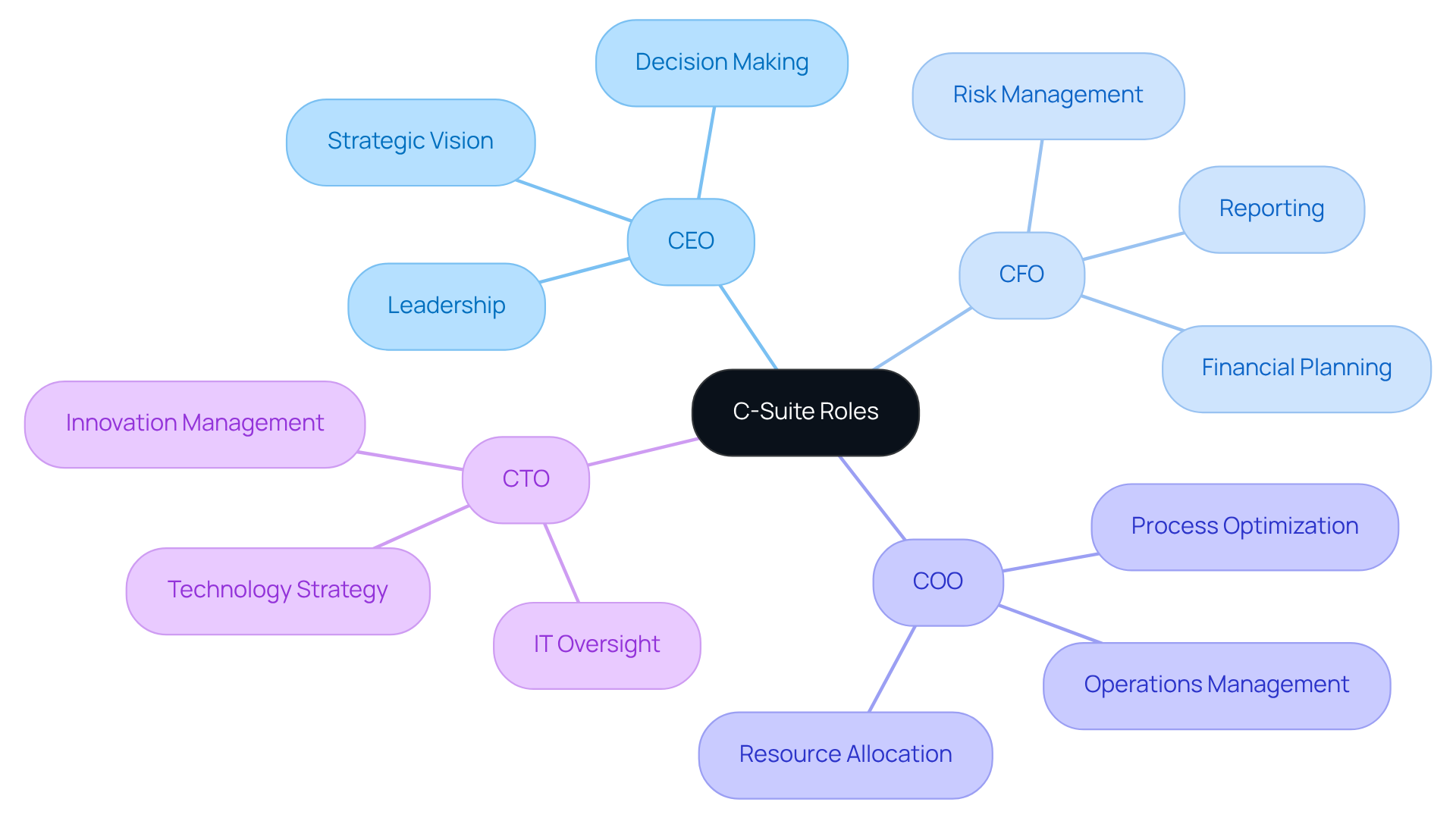
Hierarchical Structure: Establishing the Chain of Command
You might be wondering why having a clear hierarchical framework in your executive organizational chart is so important. Well, it’s all about defining the chain of command! This executive organizational chart helps everyone understand the reporting relationships, making decision-making smoother and accountability clearer. When employees can visualize the executive organizational chart, they can easily identify their superiors and understand the flow of authority, which is essential for maintaining efficient operations.
Now, let’s dive into how SowFlow can help with this. With its immediate documentation solution, operations managers can whip up and update structure diagrams and user guides that lay out the hierarchy. This means that all team members have access to the latest info, which streamlines process standardization and makes onboarding a breeze. Plus, it enhances knowledge sharing, ultimately giving your team a nice boost in efficiency. So, why not explore how effective documentation can transform your organization?
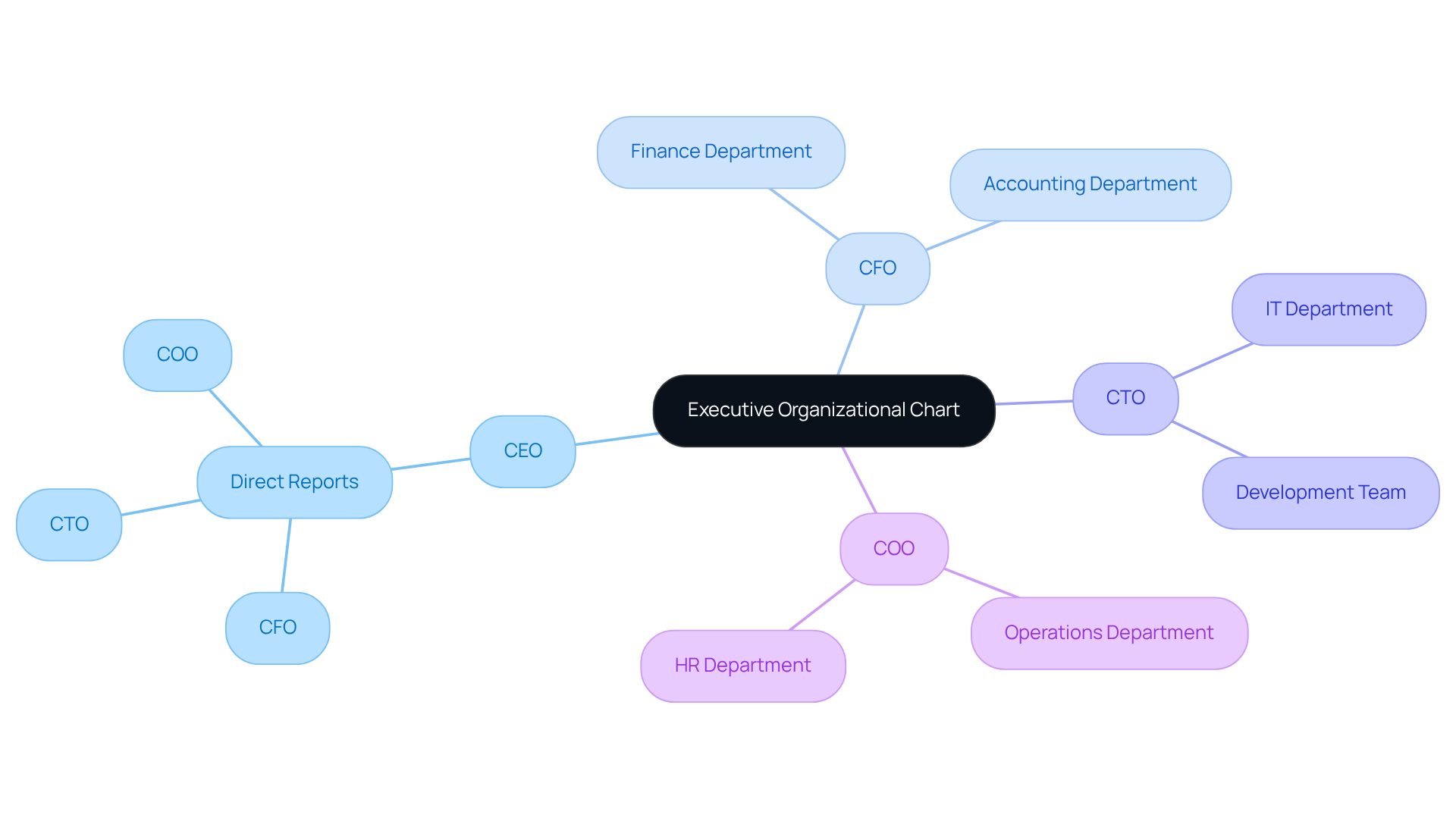
Visual Representation: Enhancing Clarity with Design Elements
You might be wondering how an executive organizational chart can really make a difference. Well, it’s all about using visual components like colors, shapes, and lines to boost clarity. When companies integrate these design features, they create visuals that are not just informative but also eye-catching. This approach helps you and your colleagues quickly grasp the company’s framework through the executive organizational chart, making it easier to understand relationships and reporting lines at a glance.
Speaking of clarity, think about how often you’ve stared at a confusing chart and felt lost. With the right design, those moments can be a thing of the past! By making these diagrams visually appealing, you’re not just sharing information; you’re inviting everyone to engage with it. So, why not explore how you can enhance the visuals of your executive organizational chart? It could really transform the way your team communicates!
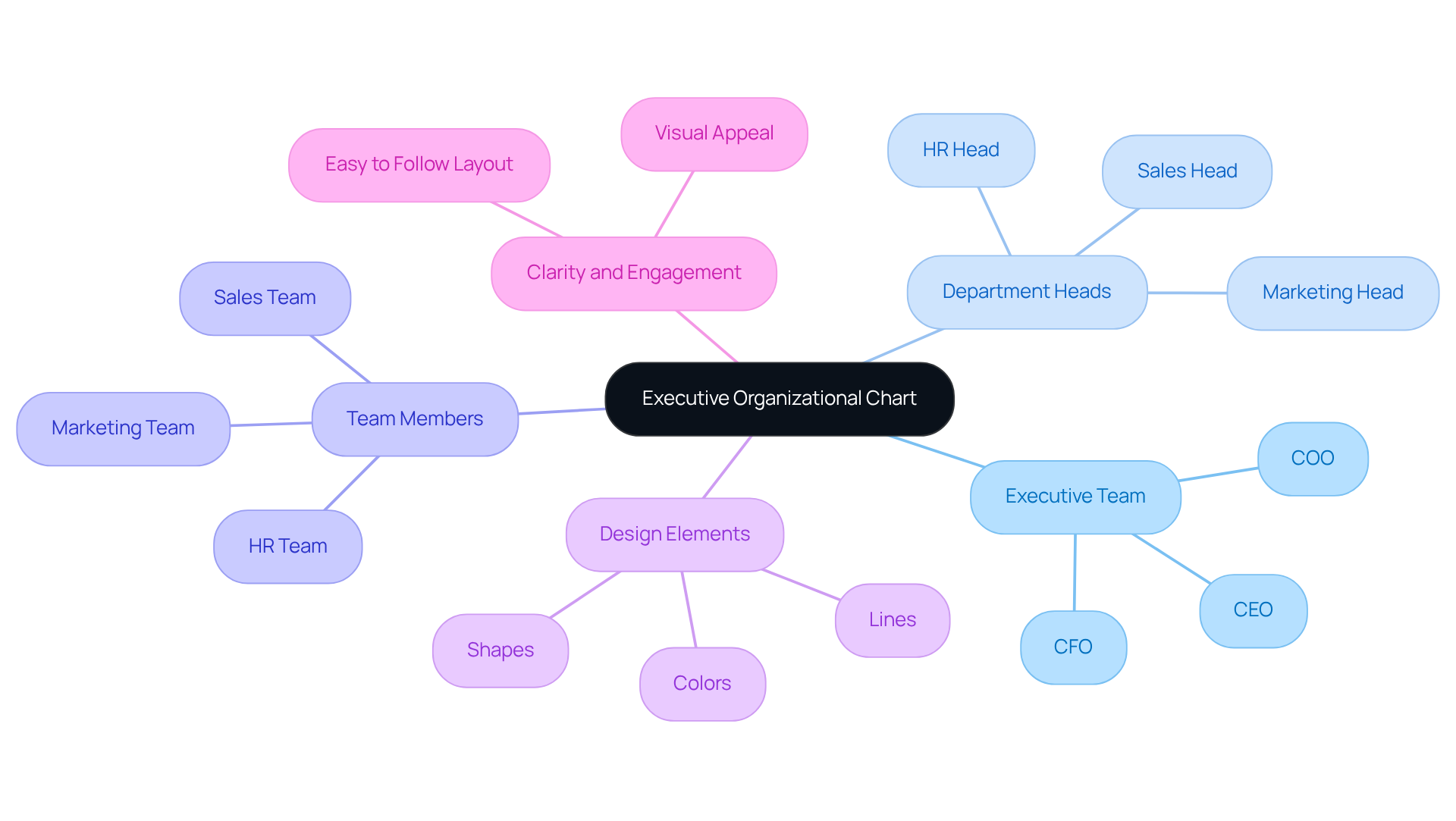
Reporting Relationships: Mapping Communication Lines
You might be wondering why mapping reporting relationships in your organization is so important. Well, it’s all about understanding those communication lines! When everyone knows who to approach for specific issues, it really helps foster a culture of open communication. By clearly outlining these relationships, you can boost collaboration and make sure that information flows smoothly at every level.
Now, let’s dive into how this clarity can make a difference. Imagine walking into your workplace and knowing exactly who to turn to when a question pops up. It not only saves time but also encourages a friendly atmosphere where everyone feels comfortable sharing ideas. So, why not take a moment to think about how your organization currently handles this? Are there gaps that could be filled to enhance that flow of information?
By taking the time to create an executive organizational chart, you’re not just mapping out these relationships; you’re building a bridge for better teamwork and communication. And who wouldn’t want that?
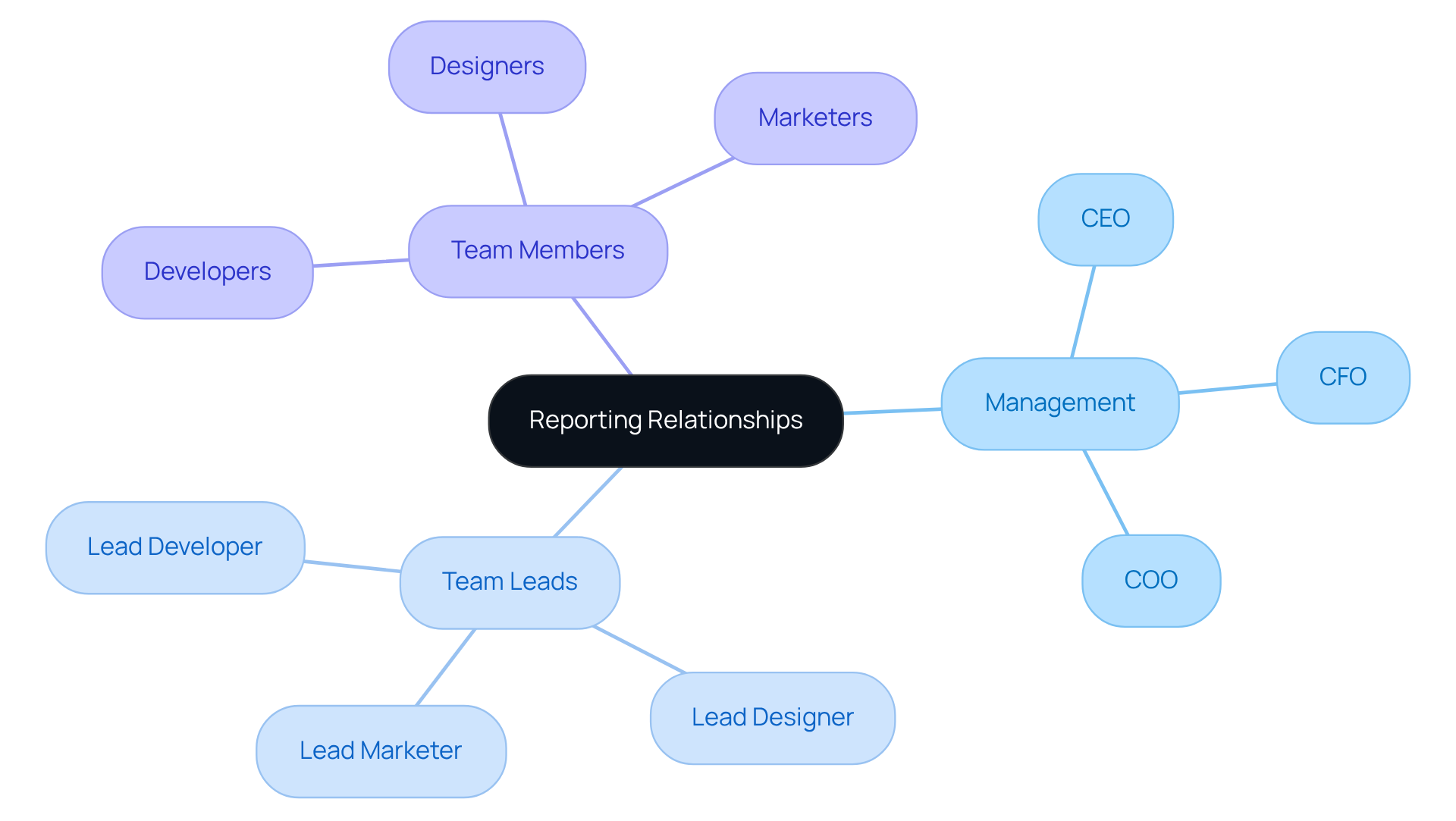
Departmental Breakdown: Structuring Teams for Efficiency
You might be wondering how segmenting a company into different divisions can really help clarify team roles and functions. Well, think about it: when each department is visually represented in the executive organizational chart, it makes it much easier to see who’s responsible for what. This structured approach, as illustrated by the executive organizational chart, not only clears up accountability but also boosts operational efficiency, allowing teams to work together smoothly toward shared goals.
For example, organizations that use functional departmentalization often find that they gain more expertise and streamline their processes. Why? Because tasks are grouped by similar skill sets, making it a breeze for everyone to know their strengths. This setup is especially handy for smaller businesses since it keeps things simple. But here’s the catch: collaboration between departments can sometimes take a hit in a functional framework, which might slow down communication.
Now, let’s dive into what’s trending! There’s a noticeable shift towards hybrid models that mix traditional structures with agile, cross-functional teams. This combo really ramps up adaptability and responsiveness to what the market demands. Operations managers often point out that having well-defined team structures leads to better communication and fewer conflicts, which ultimately boosts performance across the board.
Plus, each division acts like its own little kingdom, complete with its own management, resources, and performance goals. This really highlights the importance of breaking things down into departments as illustrated in the executive organizational chart. And speaking of that, let’s not forget the four types of departmentalization—Functional, Product, Geographical, and Customer/Market. Each of these offers unique strategies for how companies can structure their teams.

Feedback Mechanism: Keeping the Chart Current and Relevant
You might be wondering how a feedback system can really make a difference in your organization. Well, establishing one is key to keeping your structure fresh and relevant! By regularly asking your team for their thoughts on changes in roles or structures, you can tweak things to fit everyone’s needs.
This isn’t just about keeping records straight; it’s about getting your employees involved in the process. When they feel like their voices matter, it nurtures a sense of ownership and responsibility. So, why not start a conversation today? It could lead to some great insights!

Technology Integration: Leveraging Tools for Chart Creation
You might be wondering how technology can really help shape your organization’s structure. Well, using tools like SowFlow's documentation software can make a world of difference! It allows for quick updates and easy sharing of graphs across your company.
By bringing these tools into play, your teams can collaborate in real-time. Imagine everyone having access to the latest info at their fingertips! That’s super important for keeping things clear and aligned within your organization. So, why not explore how these solutions can work for you?
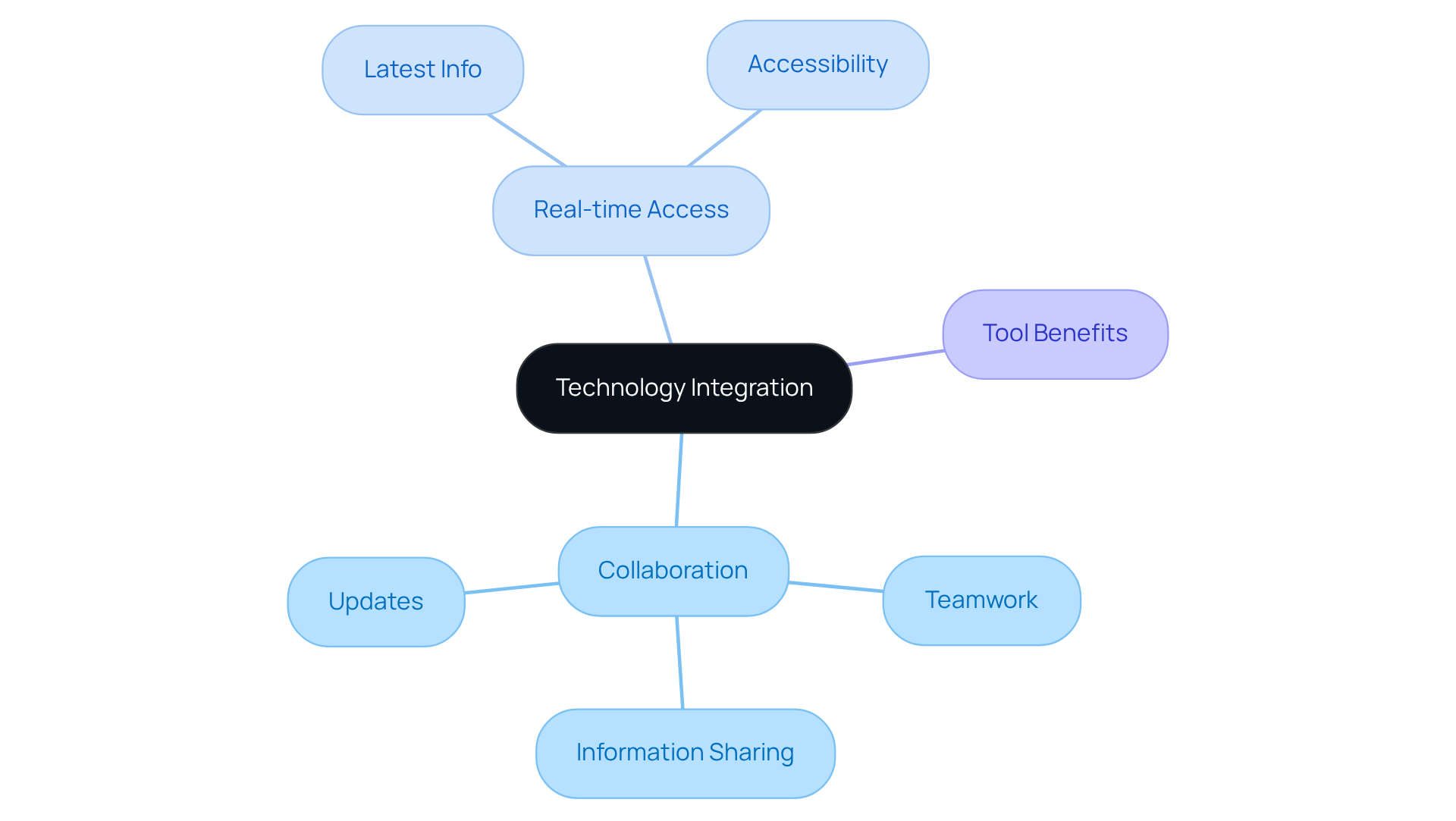
Regular Updates: Maintaining Accuracy in Organizational Charts
You might be wondering how to keep your executive organizational chart updated. Well, maintaining precision in the executive organizational chart means you need to regularly update it to reflect changes like new hires, promotions, or departmental shifts. Creating a routine for reviewing and updating your documents can really help. It ensures that everyone has a dependable resource at their fingertips.
Now, let’s dive into how SowFlow can make this process a breeze! With its immediate documentation solution, your teams can share and access updates in just seconds. This not only boosts the credibility of your data but also supports effective communication across the board. Imagine how much smoother things would run when everyone is on the same page!
This practice doesn’t just streamline process standardization; it also fosters knowledge sharing. And let’s be honest, who doesn’t want to contribute to operational efficiency? So, why not take a moment to think about how you can implement these updates in your own organization? It could make a world of difference!
Onboarding Alignment: Integrating Training with the Organizational Chart
You might be wondering how to make new employee orientation smoother and more effective. Well, incorporating the company hierarchy into the onboarding process can really do the trick! By giving new hires an executive organizational chart, they can quickly understand the structure, key roles, and reporting relationships. This clarity not only helps them navigate their new environment but also makes their transition a whole lot easier and faster.
Did you know that research from the Brandon Hall Group shows effective onboarding can boost new hire productivity by over 70%? That’s pretty impressive! Plus, HR specialists point out that a well-structured onboarding experience, especially one that includes visual tools, can improve retention rates by up to 82%. So, it’s clear that a little planning goes a long way.
Now, let’s dive into some innovative practices! In addition to using an executive organizational chart, many companies are adopting regular check-ins and mentorship programs. These strategies really enhance understanding and engagement among new hires, making them feel more connected right from the start. So, what do you think? Ready to explore these ideas further?
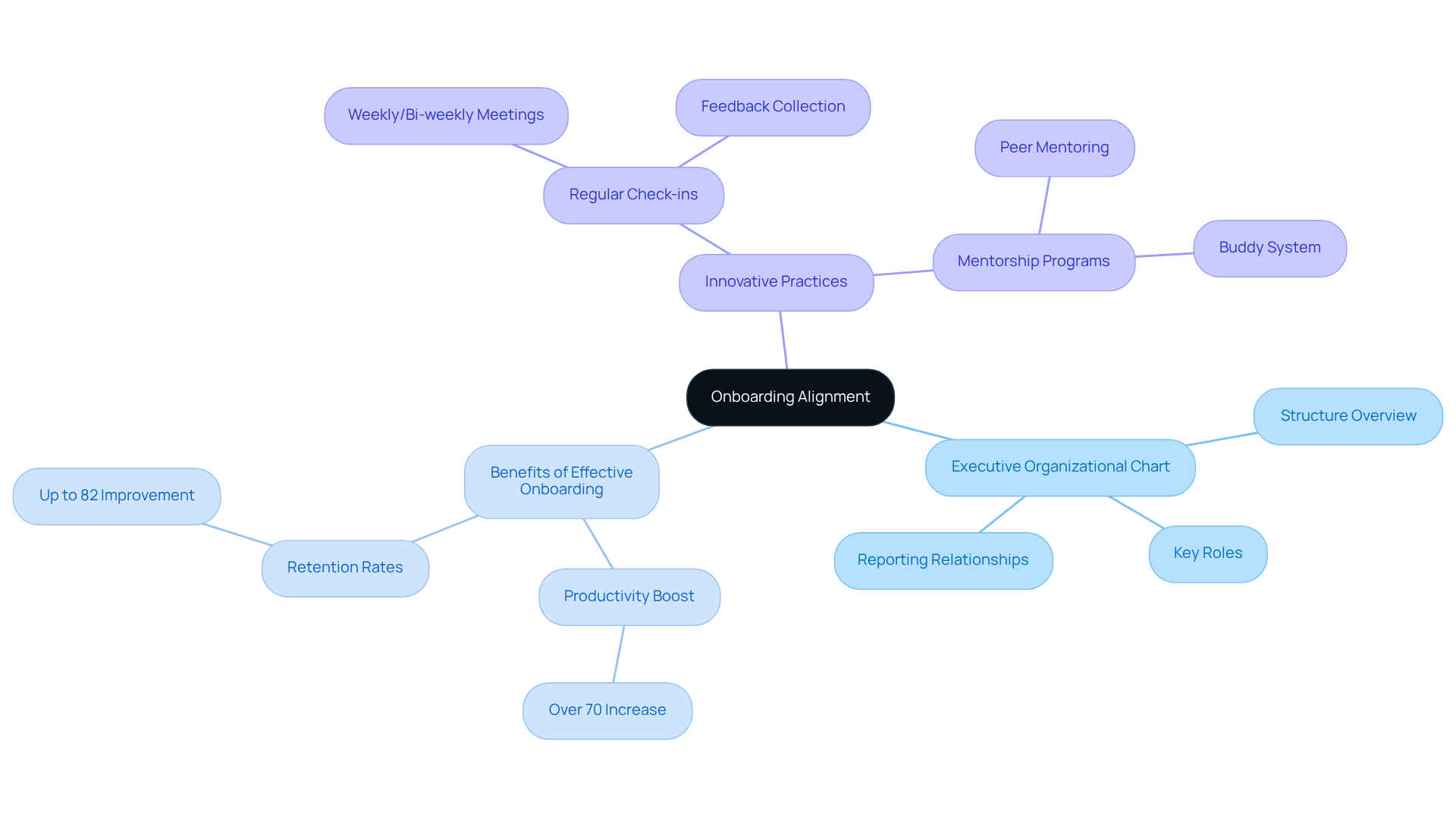
Conclusion
Creating an effective executive organizational chart is super important for clarifying roles, responsibilities, and communication lines within your organization. You might be wondering how to make this happen, right? Well, by using tools like SowFlow, companies can really streamline their documentation processes. This way, everyone has access to up-to-date info that boosts collaboration and efficiency. A well-defined structure is key—it directly impacts decision-making, accountability, and the overall success of the organization.
Throughout this article, we’ve touched on some key elements, like:
- Defining C-Suite roles
- Establishing a clear hierarchy
- Enhancing visual representation
- Mapping out reporting relationships
Each of these components is crucial for helping employees understand their place in the organization and how they contribute to its goals. Plus, keeping things fresh with regular updates and integrating feedback mechanisms is vital for ensuring the organizational chart stays relevant and effective.
So, in conclusion, the significance of an executive organizational chart goes beyond just being a piece of documentation; it’s really the backbone of effective communication, team alignment, and operational efficiency. Organizations should take a moment to evaluate their current structures and explore innovative practices that can enhance clarity and engagement. By focusing on these elements, companies can create a more cohesive work environment that empowers employees and drives success. Now, doesn’t that sound like a plan?
Frequently Asked Questions
What is SowFlow and how does it help organizations?
SowFlow is a platform for creating and managing executive organizational charts, making it easier for teams to understand roles and responsibilities within the organization. It streamlines documentation, saving time and boosting efficiency by clarifying the hierarchy and reporting lines.
What are the key executive roles in the C-Suite?
The key executive roles in the C-Suite include the CEO (Chief Executive Officer), CFO (Chief Financial Officer), COO (Chief Operating Officer), and CTO (Chief Technology Officer). Each role has specific responsibilities that are crucial for the company's success.
Why is it important to define roles in the C-Suite?
Clearly defining roles in the C-Suite helps avoid overlaps in responsibilities, ensuring each executive knows their specific duties. This clarity streamlines decision-making and enhances communication across departments, fostering a collaborative environment.
What is the significance of having a clear hierarchical structure in an organization?
A clear hierarchical structure defines the chain of command, helping employees understand reporting relationships. This clarity facilitates smoother decision-making and accountability, which is essential for efficient operations.
How does SowFlow assist with establishing a hierarchical structure?
SowFlow provides immediate documentation solutions that allow operations managers to create and update structure diagrams and user guides. This ensures that all team members have access to the latest information, streamlining process standardization and improving onboarding.
What benefits does effective documentation offer to an organization?
Effective documentation enhances knowledge sharing, boosts efficiency, and ensures all team members are informed about the organizational structure and processes, ultimately leading to better operational performance.
👍
What others are liking
5 Steps to outline your ideal documentation structure
5 MINS READ
Where to start the your journey of mapping out your ideal documentation structure, aligning it with the very heartbeat of your organization?
Defining a winning level of detail in your process
3 MINS READ
What is too much detail, and what is too little? This article described in that winning level detail about what detail is enough.





